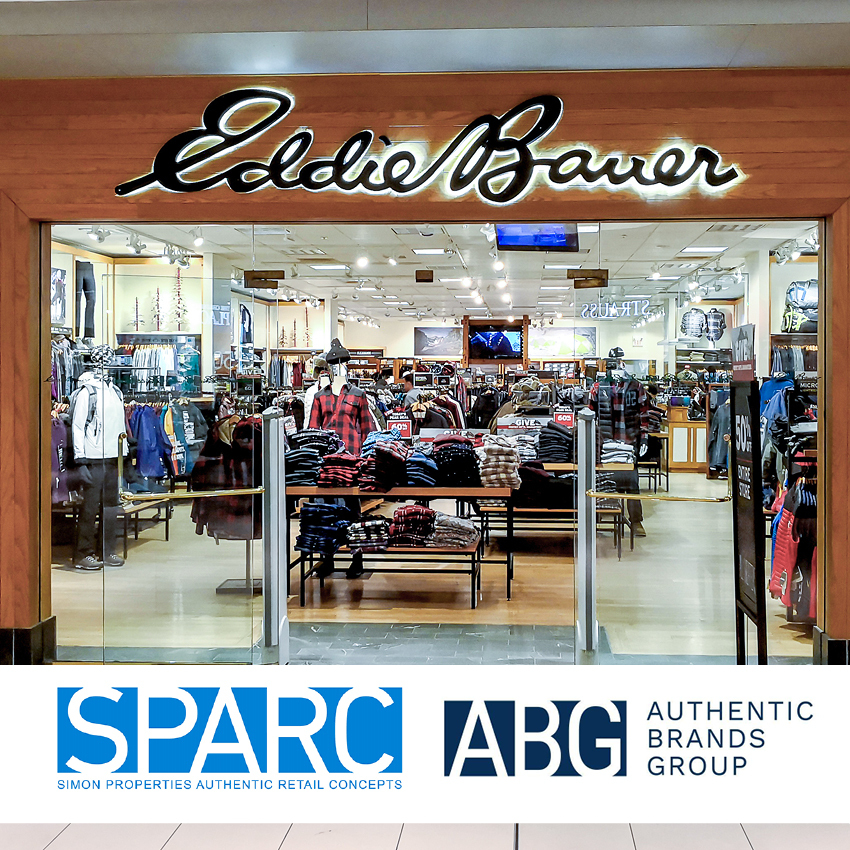SPARC: Maybe this acronym for the Simon Property Authentic Brands Retail Concepts was purposely crafted to send a message that many of the withering Simon Properties’ malls, co-owning and leasing spaces to many of the stale and losing brands in the Authentic Brands portfolio, would spark new life into both. I wrote about Simon and Brookfield’s acquisition of the dying JC Penney, Too Big to Fail stating that it was a short-term move to save Simon’s and Brookfield’s butts from a massive exit of not just JCP but also the hundreds of other specialty chain stores in their malls. The SPARC model is more of the same – a short-term butt protector for Simon Properties—and a real and costly big-time risk for Authentic Brands.
Eddie Bauer Joins the Family
SPARC’S most recent acquisition is Eddie Bauer, a brand that has been struggling for years, under a revolving door of CEOs who attempted to spark some younger, cooler and upscale life into its DNA. Back in 2009 while the brand was in bankruptcy, VF Corporation — owner of great brands such as Vans, The North Face, Timberland, and Supreme, among many others — became a “party of interest,” but subsequently walked away from bidding for Eddie Bauer. My only reason for mentioning the VF interest is because in my opinion, VF’s disinterest in Eddie Bauer signaled VF believed it had no future. Even with the best-in-class brand builder that VF is, particularly in the outdoor and active sports apparel space, VF pretty much signaled that Eddie Bauer was a dead brand walking.
So, with the addition of the Eddie Bauer brand and its roughly 300 stores, SPARC amplifies its portfolio of Aeropostale and its 400 stores, Forever 21 with 448 stores, Brooks Brothers with 125 stores and the recently acquired Lucky Brands with 200 stores. This totals 1473 stores owned by SPARC and many of them are currently housed in Simon Property malls.
And let’s not forget the non-SPARC mess of JC Penney. I’m sure that part of the calculous for turning around both JCP and the stable of SPARC current losers is to stick the losing brands into some 690 dying JCP stores as well as their own stores in the Simon malls. Sorry to be so harsh, but in today’s marketplace of endless aisles of over-choice for consumers, the convenience and speed of the internet, and a new generation of young consumers that turned off malls and these stale brands years before the Great Recession and the pandemic, SPARC and its assets are going to have to find magic somewhere else.
We’ve Seen This Movie
Need I refer, once again, to Eddie “fast buck” Lampert, the brilliant financier who managed the Kmart/Sears Titanic into the briny (while pocketing tons of cash); and Richard Baker, the brilliant real estate mogul, who is currently defaulting to what he does best, which is not retailing?
My point is, David Simon is a brilliant mall developer and manager, which is not retailing. And Jamie Salter, former CEO of Hilco Consumer Capital, is touting himself as a brilliant brand strategist, which is also not retailing.
However, the difference between Baker and Lampert and Simon and Salter is that the S&S don’t have other core skills to default to. So, they are simply doubling down on their current mall and brand combos. Get it? Just continue to do more of what they have always done in the same way. Insanity.
Hope for Transformation
Simon did recently state in a WWD interview that “…they have been actively transforming several of its shopping centers with different services, end-uses and experiences, such as gyms, clinics, groceries and residences, to be more relevant and less dependent on traditional retailing. For example, at the Northgate center in Seattle, Simon is adding the National Hockey League’s Seattle Kraken corporate offices and practice and training facility. At Phipps Plaza in Atlanta, there will be a Nobu Hotel and Restaurant, Citizens food hall, Life Time athletic club and Life Time Work. In addition, construction continues redevelopments at the North Shore and Burlington malls, both in the Boston area, at the West Town Mall in Knoxville, Tenn., and the Tacoma Mall in Washington. In the U.K., the West Midlands Designer Outlet opened on April 12 upon the lifting of COVID-19 restrictions, which delayed the initial opening date. The open-air center has 197,000 square feet; Simon owns a 23 percent interest in the center.” My opinion of this is that it will be too little too late.
A Prayer for Repositioning
And Salter talks a great game about the process of brand repositioning as we reported in The Robin Report. Well, I’m sorry folks. I may be missing something. But one of the most important steps in repositioning a dying brand is creating its distribution strategy. And I’m sorry to say that malls, particularly those anchored by losing department stores like JC Penney, would probably not even be on the radar of a distribution strategy for a turnaround brand. Forget about new brand imaging for the stale SPARC brands. If the first optics for consumers are those old and withering brands trying to look new, cool and young housed inside of big old and trying-to-look-young malls, the turnaround doesn’t even get out of the starting gate.
It\’s the Consumer, Always
Young consumers, the dominant new cohort live on a jet-propelled planet, re-engineering values, shopping behaviors, and demands for new, better, faster, more convenient, personalized, intimate, friendly, all-inclusive, diverse, equality, and fun, pleasant experiences — what have I missed?
Technology and entrepreneurial innovations are serving these new demands. Old, pre-tech models face the necessity to fundamentally transform their models (buying or building). Otherwise, they’ll be managing a SPARC-like portfolio into a long, slow, Sears-like death.
I’m just saying.




